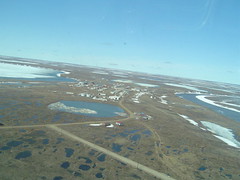 There is a reason they call it frost bite.
There is a reason they call it frost bite.Okay, so as I write this
our weather is -43 F with a slight easterly breeze of 5 mph. That gives us a windchill of 63 degrees below zero. School was canceled (for students) on Monday because of similar temperatures and today seems to be shaping up the same way.
I always have mixed feelings about canceling school because of low temperatures. We
do live in the Arctic, after all. Can we really afford to give up on educating children every time it's really cold? I am one of those teachers who
hates to see kids lose momentum and missing a day here or there can definitely lead to a stall. Moments in school are precious and my fingers often have to be
pried away from time on task.
On the other hand, I
absolutely understand the need for caution. The potential for frost bite, especially with children who aren't particularly mindful of such things, is a real danger. On several occasions I have developed blisters on my fingertips (like the one in the photo) even
while wearing gloves! Thankfully, the blisters have healed quickly leaving little more than peeling skin to attest to my pain. Not a big deal compared to some of the injuries I've seen lately.
Forty below seems to be the magic number (click the link for Clare's excellent description). It's the only common point on the Fahrenheit and Celsius scales. Barring the escalating effects of wind, forty below is forty below whether you live in Alaska, Canada, Siberia, or even Antarctica. It's like the
Bermuda Triangle of the thermometer. Once that threshold is reached or crossed, strange things begin to happen to both man and machine.
A few years ago, the insurance company that covers our school district vehicles declared that it would not continue coverage if the vehicles were used while temperatures were -40 or colder. So, on the coldest days of the year, vehicles are placed in heated garages, planes don't fly, and if someone feels the need to get out, it's their skin...quite literally.
Meanwhile, dedicated faculty and staff haunt the corridors of an empty school, secretly thankful for the windfall of extra time for getting work done. And my sister, who lives down around Fairbanks, is out getting video of her own kids experimenting with
bubbles at 40 below. I thought some of you might enjoy seeing one of the
weird and
wonderful effects of extreme cold.









